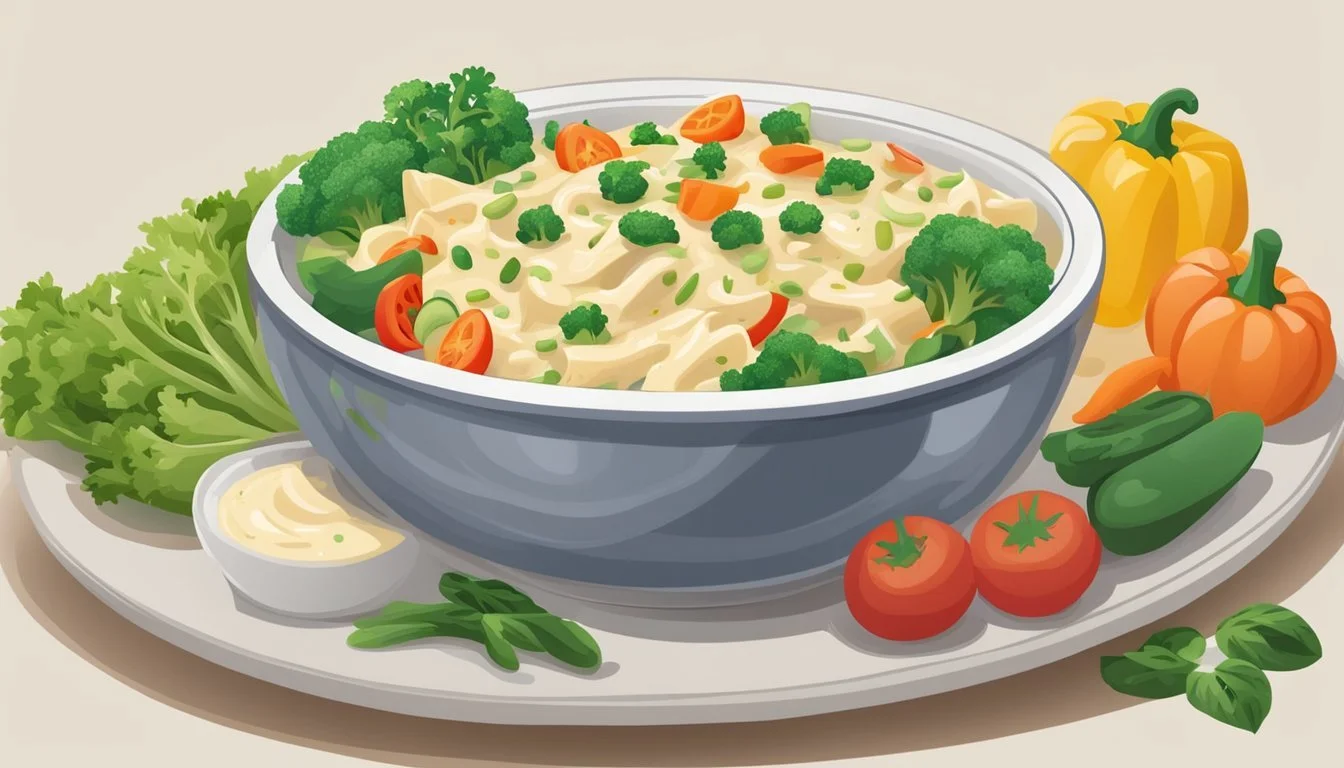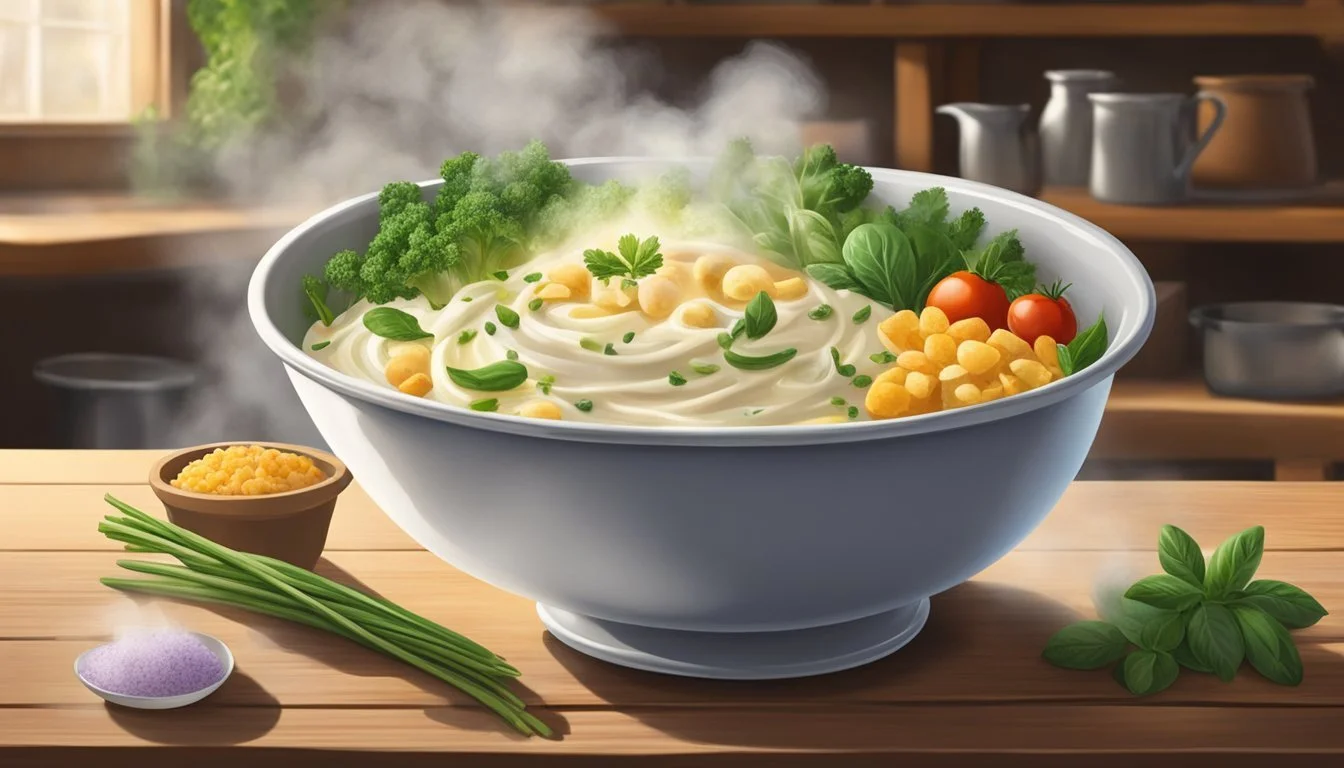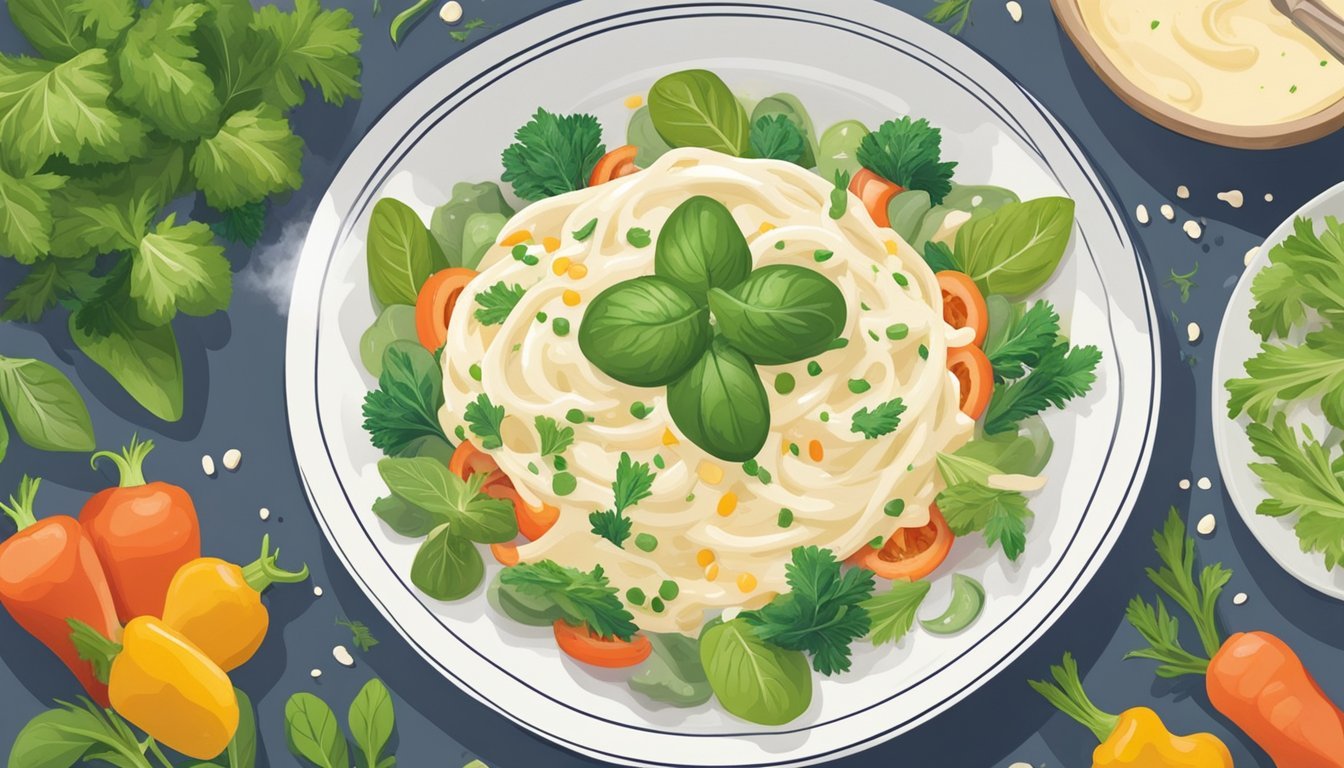How Long Does Alfredo Primavera Last?
Storage Tips and Shelf Life
Alfredo Primavera is a delicious and creamy pasta dish that marries the richness of Alfredo sauce with the vibrant flavors of fresh vegetables. Whether you've made a large batch or have some leftovers from dinner, it's essential to know how long you can safely enjoy this dish. Properly stored, Alfredo Primavera can last in the refrigerator for up to 3 to 5 days.
Understanding the shelf life of Alfredo Primavera helps ensure that the dish remains safe and delicious. Unopened Alfredo sauce typically has a longer shelf life, lasting about 6 to 12 months, depending on whether it's store-bought or homemade. However, once combined with cooked vegetables and pasta, the overall storage time decreases.
To maximize freshness, always store Alfredo Primavera in an airtight container and refrigerate it promptly. Reheating leftovers properly is also crucial; gently warming the pasta on the stove or in the microwave will help maintain its creamy texture and prevent any unpleasant food safety issues.
Understanding Alfredo Primavera
Alfredo Primavera, a delightful fusion of rich Alfredo sauce and vibrant Primavera vegetables, brings together the creaminess of dairy and the freshness of sautéed veggies. This dish is a testament to how diverse culinary traditions can come together into one harmonious plate.
Origins and Variations
The origins of Alfredo sauce can be traced back to early 20th-century Italy, credited to Alfredo di Lelio, who created it for his wife. On the other hand, Pasta Primavera, a dish featuring fresh vegetables, originated in the United States in the 1970s. Combining these two, Alfredo Primavera takes the best of both worlds, pairing creamy cheese and heavy cream with a light, vegetable-loaded profile.
Variations abound, allowing for different vegetables, types of pasta, and sometimes added proteins like chicken or shrimp. Each variation offers unique flavors while maintaining the fundamental mix of creamy sauce and fresh vegetables.
Key Ingredients
The key ingredients of Alfredo Primavera include pasta, typically fettuccine or penne, Alfredo sauce, and an assortment of fresh vegetables.
Pasta: Traditionally, fettuccine or penne is used, but other shapes like pappardelle work as well.
Alfredo Sauce: This creamy sauce is made with a mixture of butter, heavy cream, and Parmesan cheese, resulting in a rich and smooth texture.
Vegetables: Commonly used vegetables include bell peppers, zucchini, broccoli, and carrots, which are sautéed to maintain their tenderness and enhance their flavors.
Protein (Optional): For added protein, chicken, shrimp, or mushrooms can be integrated into the dish, making it more substantial.
Nutritional Information
Alfredo Primavera is a rich dish that balances creamy textures with fresh vegetables.
Calories: The dish is calorie-dense, primarily due to the Alfredo sauce, which contains heavy cream and butter. A single serving can range between 500-700 calories, depending on ingredient quantities.
Protein: If chicken or shrimp is added, the protein content increases significantly. Without these, the protein mostly comes from Parmesan cheese and vegetables.
Fat: The sauce contributes a high amount of fat, but using more vegetables can offset some of this.
Vitamins: The fresh vegetables in the pasta provide essential vitamins and minerals, making the dish not just delicious but also somewhat nutritious.
Balancing rich ingredients with fresh, healthy vegetables makes Alfredo Primavera a beloved dish for those who enjoy robust flavors.
Preparation Techniques
Creating a delicious Alfredo Primavera involves key techniques: cooking pasta to perfection, crafting a rich Alfredo sauce, and incorporating a variety of veggies to balance the dish's flavors.
Cooking Pasta Al Dente
To achieve the ideal texture, pasta should be cooked al dente according to the package instructions. Begin by boiling water in a large pot, adding salt to enhance flavor. Add the pasta and cook until it is firm to the bite.
Use a timer to avoid overcooking, which can result in mushy noodles. Drain the pasta and rinse it with warm water to prevent sticking. Set aside and reserve some pasta water to adjust sauce consistency if needed later. These steps ensure the pasta holds up well when mixed with sauce and vegetables.
Creating the Alfredo Sauce
Alfredo sauce is the backbone of this dish. Start by melting butter in a saucepan over medium heat. Add heavy cream and bring to a gentle simmer. Stir frequently to avoid burning and ensure a smooth texture.
When making the sauce, use fresh ingredients like grated Parmesan cheese, which melts uniformly and imparts a rich taste. Additional garlic can enhance the flavor profile, as can a sprinkle of nutmeg or black pepper. Continually stir until the cheese is fully incorporated and the sauce thickens to a creamy consistency.
Adding the Veggies
A variety of veggies adds color and nutrition to Alfredo Primavera. Begin by sautéing garlic and onion in olive oil until fragrant. Add a mix of vegetables such as broccoli, bell peppers, zucchini, and squash. These should be cut into uniform pieces for even cooking.
Sauté the vegetables until they are tender but still crisp, typically for about 2-3 minutes. Transfer the cooked veggies to a large bowl and mix them with the prepared pasta. Add the warm Alfredo sauce and a bit of reserved pasta water if needed to reach the desired consistency.
Combining these elements results in a balanced and flavorful Alfredo Primavera that's pleasing to both the eye and the palate.
Flavor Enhancements
Enhancing the flavor of Alfredo Primavera involves carefully selecting herbs, spices, proteins, and cheeses. These additions can elevate the dish and create a more complex and satisfying flavor profile.
Herbs and Spices
Herbs and spices add depth to Alfredo Primavera. Fresh basil, parsley, and oregano are excellent choices. Basil, with its sweet, peppery notes, pairs perfectly with the sauce's richness. Parsley adds a fresh, grassy flavor, providing balance. Oregano offers a bold, earthy taste. Seasoning with kosher salt and freshly ground black pepper ensures a well-rounded flavor.
Experimenting with spices like garlic powder or red pepper flakes can enhance the dish further. Garlic powder brings a subtle, savory undertone, while red pepper flakes add a touch of heat.
Protein Additions
Adding proteins can intensify the dish's richness and make it more filling. Popular options include chicken, shrimp, and salmon. Grilled chicken chunks complement the creamy sauce's flavors well, providing a hearty texture. Shrimp adds a sweet, briny taste, blending seamlessly with the vegetables and sauce.
For a vegetarian option, consider tofu. It's a versatile protein that absorbs the flavors of the sauce and spices, offering a balanced texture. Season the tofu with salt and pepper before cooking to enhance its flavor profile.
Cheese Varieties
Cheese plays a vital role in adding richness to Alfredo Primavera. Parmesan cheese is a classic choice; its nutty, salty flavor enhances the dish significantly. Freshly grated Parmesan ensures optimal melting and flavor infusion.
Exploring other cheeses can also be rewarding. Pecorino Romano, with its sharper, tangier profile, can add another layer of complexity. A sprinkle of mozzarella adds creaminess, while a touch of Gouda can introduce a slight smokiness.
Pairing multiple cheeses can result in a unique and enhanced flavor experience, making the dish more indulgent and satisfying.
Serving Suggestions
Alfredo Primavera can be enhanced with complementary pairings and thoughtful presentation to elevate the dining experience. Incorporate fresh ingredients and simple garnishes to add both flavor and visual appeal.
Appropriate Pairings
Salads: Pair Alfredo Primavera with a crisp Greek pasta salad or a simple mixed green salad. The refreshing crunch of fresh vegetables balances the creamy richness of the Alfredo sauce. Use a light vinaigrette with lemon juice to keep flavors bright and harmonious.
Beverages: White wine, such as a Sauvignon Blanc or Pinot Grigio, complements this dish well. These wines' acidity cuts through the creaminess, enhancing the overall dining experience.
Bread: Serve with a warm, crusty baguette or garlic bread. The bread is perfect for sopping up any extra Alfredo sauce, ensuring none of the delicious flavors go to waste.
Presentation Ideas
Plating: Serve Alfredo Primavera in shallow bowls or on wide plates. This allows the pasta and vegetables to be spread out, showcasing the vibrant colors of the dish.
Garnishes: Use fresh basil and grated parmesan cheese as garnishes. These add both a burst of color and an extra layer of flavor. A sprinkle of lemon zest can also brighten up the presentation and provide a fresh, citrusy kick.
Final Touches: For added elegance, place a thinly sliced lemon wedge on the side of the plate. This not only adds visual interest but also allows diners to add a touch of lemon juice if they desire.
By paying attention to pairings and presentation, Alfredo Primavera can be transformed from a simple pasta dish into a memorable meal.
Storage and Shelf Life
Ensuring the proper storage of Alfredo Primavera is vital to maintaining its freshness and flavor. This section covers the best methods for refrigeration, freezing, and reheating to maximize shelf life.
Refrigeration Best Practices
Alfredo Primavera leftovers should be refrigerated promptly to prevent spoilage. Transfer the dish into an airtight container to minimize exposure to air and moisture. In the refrigerator, the sauce and vegetables will generally last for about 3 to 5 days. Keeping the fridge temperature at or below 40°F (4°C) is essential for preserving its quality. Label the container with the date to easily track its storage time.
Freezer Storage Solutions
Freezing Alfredo Primavera can extend its life significantly. Place the cooled leftovers into a freezer-safe container or heavy-duty freezer bag. Ensure that as much air as possible is removed to prevent freezer burn. Properly stored, Alfredo Primavera can last up to 3 months in the freezer. For convenience, individual portions can be frozen separately, making reheating easier and reducing waste.
Reheating Instructions
For best results, reheat Alfredo Primavera using the stovetop or oven. If using the stovetop, place the leftovers in a saucepan over low to medium heat and stir occasionally until heated through. Adding a splash of water or cream can help maintain the sauce's consistency. In the oven, preheat to 350°F (175°C), cover the dish with aluminum foil, and bake for about 20-25 minutes. The microwave can also be used, but it may result in uneven heating and drier textures. Heat in short intervals, stirring between each, to ensure even reheating.
Health Considerations
Alfredo primavera is a creamy, vegetable-rich dish that offers a blend of flavors and nutritional benefits. It's essential to consider both the caloric content and possible dietary modifications to make it suitable for various health needs.
Caloric Content
Alfredo primavera typically contains a significant number of calories due to its creamy sauce and pasta base. A standard serving can range from 400 to 600 calories. The sauce, made predominantly of cream, butter, and cheese, contributes the most to this caloric content.
Fresh veggies such as bell peppers, broccoli, and zucchini add vitamins and fiber but are low in calories compared to the sauce.
The protein content can vary based on the addition of ingredients like chicken or shrimp, making it more filling but also increasing the overall caloric count.
For those watching their calorie intake, portion control and balancing with lower-calorie foods throughout the day can help.
Dietary Modifications
To accommodate different dietary requirements, several modifications can be made to alfredo primavera:
Dairy-free options: Replace traditional cream and cheese with plant-based alternatives like almond milk and nutritional yeast. These substitutes lower the calorie count and make the dish suitable for lactose-intolerant individuals.
Gluten-free choices: Substitute regular pasta with gluten-free pasta (e.g., made from rice or quinoa). This makes the dish accessible to those with gluten sensitivities or celiac disease.
For a vegetarian pasta version: Ensure no meat is added, focusing instead on fresh veggies and optionally adding plant-based proteins like tofu.
These adjustments not only make the dish suitable for various dietary needs but also can enhance its nutritional profile.
Variations and Alternatives
When making Alfredo Primavera, there are several ways to customize the dish using seasonal vegetables, alternative ingredients, and specific vegetable preparation techniques. These adjustments can enhance the dish's flavor and nutritional value.
Seasonal Variations
Using seasonal vegetables ensures freshness and optimal flavor. In spring, zucchini, asparagus, and fresh thyme are excellent choices. Summer offers bell peppers, tomatoes, and spinach, which add vibrant colors and taste.
During fall, incorporating cauliflower and butternut squash provides a comforting twist. Winter vegetables like broccoli and brussels sprouts can make the dish hearty.
Adapting the recipe to the season not only makes the meal more enjoyable but also supports local, fresh produce.
Alternative Ingredients
There are many ingredient alternatives to cater to dietary needs and preferences. For those who are lactose intolerant, using a dairy-free Alfredo sauce made from cashews or almond milk can be effective.
For a protein boost, adding grilled chicken or shrimp is popular. Vegetarians may consider tofu or tempeh as protein-rich substitutes.
Choosing whole grain or gluten-free pasta is another alternative that can cater to dietary restrictions while adding nutritional benefits.
Vegetable Preparation
The preparation of vegetables can significantly affect the dish's texture and flavor. Sautéing vegetables like zucchini, bell peppers, and spinach ensures they remain crisp-tender and retain their vibrant colors.
Roasting or grilling options, especially with cauliflower or broccoli, can add a smoky depth. Placing vegetables on a cutting board, ensuring even cuts, and seasoning them before cooking, is crucial.
Combining different methods, like starting with roasting and finishing in the sauce, can enhance the overall taste of the Alfredo Primavera.
Implementing these variations and alternatives allows for a more personalized and delicious Alfredo Primavera experience.









